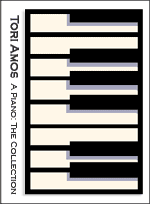- Articles
- Cherries
- Minutiae
- Q&A
- RAINN
- Releases
- Reviews
- Site News
- Them
- Toriphiles
- Touring
- TV/Radio/Web
- Video
News Archives
Keep an eye on our Twitter and Facebook pages since we often post quickie updates there when we're on-the-go.
During tours, we do our best to cover setlists in real-time on Twitter. If you want to tweet a show in, just DM or @ us on the day and tell us to watch your stream that night.
Tori is touring in 2017 to support the release of Native Invader. The European legs runs from early September through early October and the North American leg runs from late October to early December. We do not know if additional dates elsewhere will be added.

Native Invader (album, 2017)

Unrepentant Geraldines (album, 2014)

Gold Dust (album, 2012)

Night of Hunters (album, 2011)

Midwinter Graces (album, 2009)
 Abnormally Attracted To Sin (album, 2009)
Abnormally Attracted To Sin (album, 2009)
Live at Montreux 1991/1992 (DVD, 2008)

American Doll Posse (album, 2007)

A Piano (boxed set, 2006)

Pretty Good Years
(bio, 2006)

Fade To Red
(DVD, 2006)
 Comic Book Tattoo (book, 2008)
Comic Book Tattoo (book, 2008)News: Scotsman ADP Review (April 27, 2007)
Fiona Shepard reviewed American Doll Posse for the April 27th edition of The Scotsman. She’s quite impressed by the record but a little mystified by the Posse.
Thanks to Toni for the link!
She’s such a doll
FIONA SHEPHERD
POP
TORI AMOS: AMERICAN DOLL POSSE
COLUMBIA, £12.99
Tori Amos’ ninth studio album American Doll Posse unveils a group of bizarre alter egos but her songwriting creates the biggest impact, says Fiona Shepherd.
DESPITE sounding like the name of some fabulously trashy punk band, American Doll Posse – Tori Amos’s ninth studio album – is so called after a bunch of alter egos she has created for this project. These five women, each ruled by a different female deity and each with their own rambling blog (you’re nobody unless you blog, right?), are listed as vocalists on the sleeve notes, even duetting with each other on some of the tracks. As seen on the album artwork, all look just like Amos in a succession of dramatic wigs and outfits.
Much like the apocalyptic futureworld invented by Trent Reznor for Nine Inch Nails’ new Year Zero album, the dolls’ personas are fleshed out online, should you care to investigate further. But, for the purposes of basic exposition, rock chick Pip is Warrior Doll; Isabel, pictured with a camera, is Documentary Doll, attempting to take objective historical snapshots; Santa is Party Doll, I’m guessing, as she holds a Martini glass while posing like Samantha from Sex and the City, and Clyde, who apparently works in an art gallery and looks a bit like Nicola from Girls Aloud, right down to the vacant expression, is Damaged Doll. The final Doll is Tori but, as Amos would surely never choose to be seen outside a photographic studio wearing a bright orange wig, she is probably not intended to be taken for the demented chanteuse herself.
Apart from an excuse to dress up and get into online fiction, the value of these creations is unclear, and something of a distraction from the album which, despite its sprawling length, is Amos’s most satisfying work for some time and one which reaffirms her reputation as a single-minded, independent, slightly left-field songwriter.
Comprising 23 tracks spanning 80 minutes, American Doll Posse is a lot to digest, as you might expect of an album featuring five distinct “contributors”. It’s really too long – for starters, you could excise the mundane Secret Spell or the formulaic MOR of Almost Rosey without any detriment to proceedings. But the mercy is that Amos, not the most easily palatable of songwriters, manages to sustain the standard admirably throughout.
Kate Bush was cited frequently as an influence in the early days of Amos’s career, but evaporated as a reference point as Amos established herself as an international force – and somewhat diluted her sound. Now the Kate factor returns with a vengeance – in the light, expressive touch on the piano; the soaring vocals; the vulnerability and lyrical references to elemental, untamed nature (wolves feature on a couple of occasions). Beauty of Speed even mentions a “deal with the universe” at one point, echoing Bush’s “deal with God” on Running Up That Hill.
There is also a rather Bush-like dedication to “the Cornish faeries” on the sleeve. The album was recorded in Cornwall, and numerous tracks evoke an open, rural setting without sounding particularly pastoral. In places, American Doll Posse feels like the edgier album Bush’s 2005 offering Aerial could have been if she wasn’t so immersed in blissful domesticity.
The similarity in their styles can be heard explicitly across American Doll Posse – on Bouncing Off Clouds, with its elegantly insistent rhythm, hippyish lyrics and an almost copycat vocal delivery, which is as comforting as fabric conditioner; on Mr Bad Man and Programmable Soda, two jaunty, eccentric, disposable ditties both with dark underbellies; on the intriguing, eerie, layered Smokey Joe and in the natural, lyrical outpouring of Amos’s offbeat sensibility which saturates Girl Disappearing.
Teenage Hustling is more strident, featuring obsessive lyrics, theatrical vocal leaps and a confrontational sexual frankness which only PJ Harvey can better. And Body and Soul actually sounds like some Harvey-lite stomp, promising seduction that feels like a threat: “I’ll save you from that Sunday sermon, boy I think you need a conversion.”
You Can Bring Your Dog is another “come hither” song, swaggering about in big black leather boots, in which Amos pledges to “comfort” her quarry with the assurance that “you’ll be too busy boy to sue her for damages”.
Enslavement, rather than empowerment, is the theme of Code Red and its dramatic, cascading piano and latent emotional turmoil make it a standout in this generally consistent collection.
The album is peppered with a handful of shorter, pithy tracks, such as Eurofolk parable Velvet Revolution, which make their mark but don’t hang around, and with reflective piano ballads, such as the tender Roosterspur Bridge and the undulating closing track Dragon.
This latter’s mantra, “don’t tell me a woman did this to you”, resonates so truthfully, even personally, that one wonders why Amos dreamt up the fictional bloggers in wigs. If, in an iPod world, listeners need greater inducement to listen to an album from start to finish, then it is the quality of the songs here which will persuade them, not the novelty personas.


